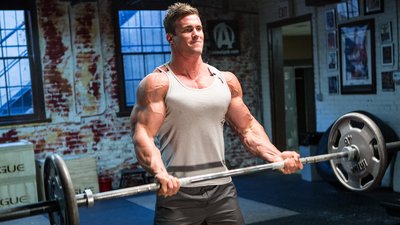It comes with the territory that when you're jacked, people are going to ask you questions about your training. For World Fitness Federation's 2014 Mr. Universe winner Calum von Moger, that means endless queries about how he trains his mountainous biceps.
We posed 13 questions to the 24-year-old Aussie, who has now made the requisite relocation to Los Angeles in search of bodybuilding fame and glory.
1. What's The Most Overrated Biceps Movement?
The single-arm cable curl done from a low pulley. [If you're too close to the pulley], any movement of your elbow away from your side can lessen the tension on the biceps as you bring the weight up.
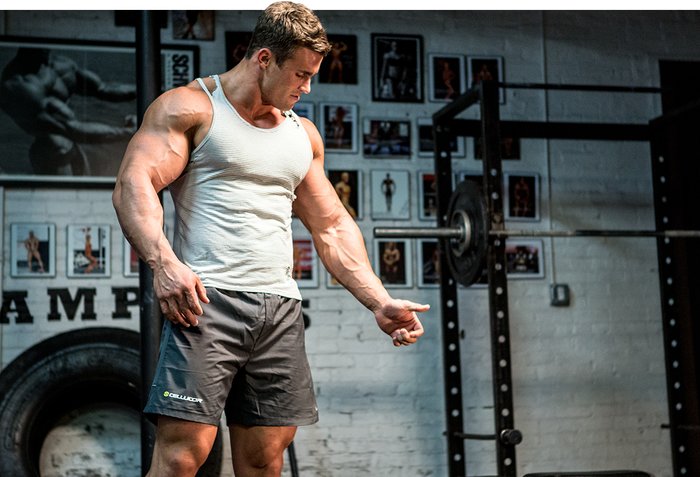
In fact, when your hand is above your elbow, the biceps are in a resting position [when your arm is fully contracted]. Here the load is on the elbow, not on the biceps. The elbow needs to stay back by the side, rather than coming forward as you raise the handle. Take a couple of steps back from the pulley to keep tension on the muscle.
2. What's The Most Underrated Biceps Movement?
The standing concentration curl with a dumbbell; it's amazing how many people do them wrong. Done correctly, it's one of the best biceps exercises and really isolates the peak, giving height to the biceps.
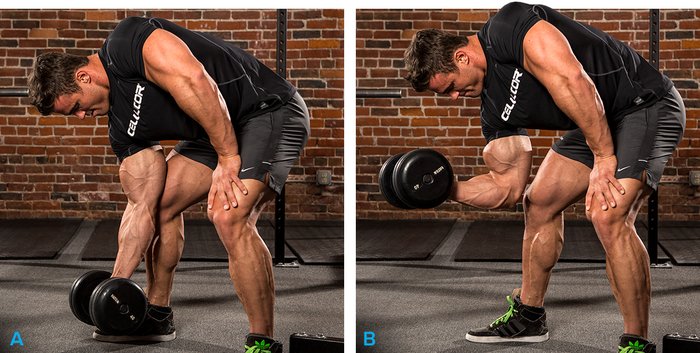
Standing Concentration Curl
I do this standing in a bent-over position with one hand on my knee. The seated version is simply called a concentration curl.
3. What's Your Favorite Biceps Exercise?
Preacher curls, because I can get a really good mind-muscle connection and my arms respond quite well to these. I find this short-head movement provides continuous tension from the bottom to the top of the range of motion. I give it a good squeeze in the peak-contracted position.
4. Any Tricks To Get More Out Of Your Preacher Curls?
I like to do 1-2 sets to "prime the pump," then several working sets of 10-12 reps each. I'll do either a dropset—reducing the weight by about 25 percent when I reach muscle failure so that I can continue the set—or partial reps: six reps from bottom to halfway up, and six more from halfway all the way to the top. When training with a buddy, on my last set I like to have him pushing down as I resist lowering the weight, which makes the eccentric movement more challenging. This leads to the most excruciating squeeze you'll ever feel in your arms.
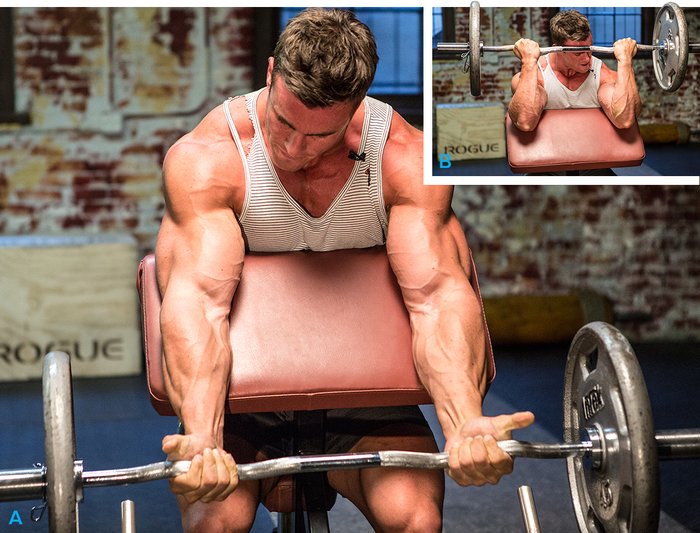
Preacher Curl
When my training partner pushes the bar downward, I'm focusing on the eccentric motion, or the negative, which is often forgotten. Since you're stronger on the eccentric than the concentric motion, this really challenges those muscle fibers more completely, really tearing them down. I believe the eccentric is just as important as the concentric phase, but it's neglected by a lot of trainers. You can do a lot more muscle damage with negatives.
5. How Does Biceps Fit Into Your Training Split?
I changed it recently. My arms are my strongest body part, and I've had to reduce the amount of arm work I do to keep my arms proportional with the rest of my body. I currently train biceps once a week with triceps. Just arms. I only do about 10 sets total for biceps. In the past, I'd go up to 20, but I've cut that in half now.
6. What About Reps Schemes When Training Biceps?
I start with a standing curl with a barbell or EZ bar. I do two warm-ups and two heavier sets. Then I like to do some kind of dumbbell curl, a preacher curl, and a concentration curl—I do 3 sets of each after the first exercise. I normally reach muscle failure around the 10th rep. I use higher reps about six weeks out from the Mr. Universe competition, as I'm trying to etch more detail into my arms. In the past I trained for weeks at a time where I'd fail at about 6 reps—that's a pretty heavy weight.
7. Do You Favor Any Special Advanced Training Techniques When Doing Biceps?
Besides doing negatives and partials, I'm a big fan of doing forced reps and dropsets. With barbell curls, I also did a lot of cheat curls. Most people don't understand the concept of a cheat curl and how it can actually help. With cheat curls, you do as many crisp reps as you can, but rather than setting the bar down when you reach a sticking point, you generate just a little bit of momentum through your knees and hips to keep the set going. This will enable you to complete a few extra reps than you ordinarily would've been able to do.
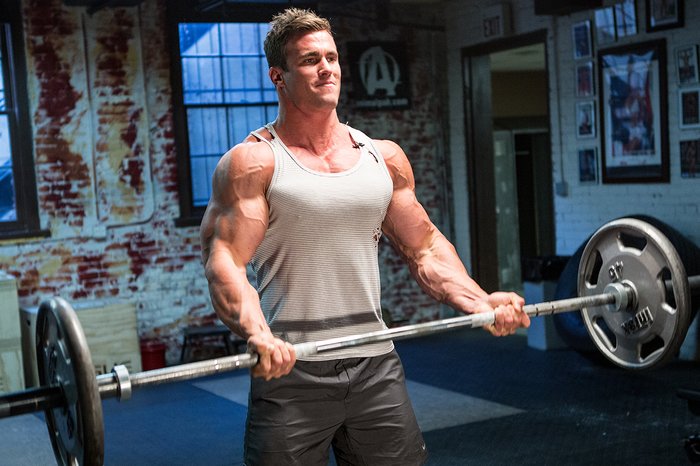
Besides doing negatives and partials, I'm a big fan of doing forced reps and dropsets. With barbell curls, I also did a lot of cheat curls.
I also like to supinate my wrists as far as I can and turn my pinkies up. This emphasizes the outside biceps head. I'll also do my hammer curls with a rope instead of dumbbells, which also allows me that slight supination at the top as I turn out my wrists. I squeeze and hold for a second at the top for extra peak contraction.
8. What's The Best Way To Increase Intensity During Biceps Training Without A Workout Partner?
Keep it intense. Sometimes I do supersets, pairing a biceps exercise with a triceps exercise, which reduces the rest time between sets. While the biceps are recovering, you train your triceps; while the triceps are recovering, you train the biceps. It's a very intense technique and reduces your total workout time.
9. What's The Biggest Mistake You See People Make When Training Biceps?
Lack of focus. The key, I think, is the mind-muscle connection. If you don't achieve it, the workout suffers and you're essentially going through the motions. Staying focused means keeping distractions away.
Aside from that, I often see people using bad form and poor technique. You must master those two things before lifting heavy weights.
10. What Was The Biggest Mistake You Made Early In Your Career When Training Biceps?
I used to get carried away trying to lift the heaviest weight I could possibly lift. After a while, you find yourself lifting really heavy weights, but it's much easier to tear a muscle, which I've actually done a couple of times. Luckily the tears were minor rather than major. Today I don't approach my biceps training like that. I've realized I don't have to be hitting those super heavy weights to be making gains.
11. Do You Have A Favorite Way To End Your Workout With A Super Biceps Pump?
Say I'm doing preacher curls: I'll do dropsets using a heavy weight and repping it out, then reduce the weight a few plates when I reach muscle failure. I do this several times. How much weight to drop is a bit intuitive; it just depends on how I'm feeling.
12. What's The Best Biceps-Training Advice You've Ever Received?
When I was getting ready for my second competition, I was told to start doing standing curls with a straight bar rather than an EZ bar, which I had always used. I could really smash those curls. But when I changed to a straight bar, my wrists began hurting a little bit because it's just more stressful with that underhand grip. After a while, however, my wrists strengthened up a bit, and I really think I was able to put more quality size on my arms by doing the Olympic curls at the start of every workout.
13. When People Ask You What Your Secret To Big Arms Is, What Do You Tell Them?
When I started out, I loved training them; I'd do it three times a week. So obviously you've got to enjoy training biceps and pushing yourself hard. Just do the challenging heavy movements first and the isolation exercises at the end. That's no real secret.



